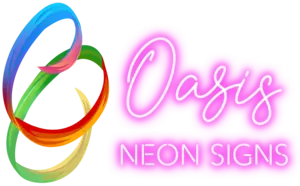
What Element Makes Glowing Signs? A Complete Guide
Share
Have you ever wondered what element makes glowing signs that pull you into a diner, bar, or quirky modern boutique? As you might have guessed, there’s an interesting science behind it. And yes, there’s an element of wonder involved.
Whether you’re a neon sign enthusiast or find these glowing signs fascinating and would love to know more about them, this comprehensive post is for you. We’ll look at neon signs, the amazing science behind their beautiful glow, and the modern LED sign alternatives.
What Element Makes Glowing Signs
Glowing signs as some might call them, are electrified glass tubes filled with a noble gas that produces a nostalgic glow when subjected to high-voltage electricity. The key element here is the noble gas, which in most cases is neon. When neon is heated up with electricity, it produces a reddish-orange glow. This explains why these glowing signs are collectively known as neon signs, even though not all contain neon gas.
The term neon is derived from the Greek word “Neos,” which means “new.” Its discovery dates back to 1898, attributed to Sir William Ramsay and Morris W. Travers. Neon gas became the go-to element for making glowing signs because it’s naturally more stable and glows in reddish-orange when electrified.
Now, here’s the interesting bit about neon gas: by itself, it glows red, which means that the reddish-orange glow is due to something else in the mix. We’ll get to that in a bit, but in the meantime, the fiery red-orange glow is due to neon.
Other Noble Gases in the Glowing Gang
Even though neon gas hogs the spotlight, several other noble gases can light up glowing signs. Let’s say that if neon is the star, the other gases make up the supporting cast, each playing a specific role.
- Argon: A mixture of argon and some mercury will give off a cool blue glow. Argon is often used with phosphor coatings to produce other hues, such as purple and green.
- Xenon: Xenon is commonly used in flash photography and strobe lights due to its blue glow. Although not common in neon signs, it has its moment.
- Krypton: Krypton is prominent for its whitish glow that is often tinged with different colors according to the coatings used. It’s not commonly used because it’s more expensive, but the glow is without a doubt impressive.
Why Phosphor Coatings?
Now, you’ve come across the phrase phosphor coatings. What are they, and why are they important to the world of glowing signs? Well, they’re an important element that makes up glowing signs.
Do you recall we mentioned that pure neon only glows red? Phosphor coatings found on the inner part of the glass tube are responsible for the various hues of neon signs. When the noble gas in the glass tube gets excited by high-voltage electricity, the phosphor coating produces different colors according to its composition.
For example, green hues are achieved when argon gas is used in combination with green phosphor coating. The blue glow is directly emitted by argon, but various shades can be achieved with coatings on the glass tube. Orange and yellow are achieved by a mixture of gases or through different phosphor coatings.
These coatings contribute a lot to making glowing signs what they are, unfortunately, they often receive little to no recognition. They make it possible for neon sign makers to get creative and offer a wider spectrum of attractive colors.

How the Classic Neon Signs Are Made
After determining the element that makes glowing signs, the next thing that’s worth knowing to make you a true neon enthusiast is how the signs are made. Well, the classic neon signs comprise sealed glass tubes filled with a noble gas and have electrodes on each end.
These three components work on the principle that the noble gas when activated produces light. Generally, high voltage current flows through the glass from one electrode to the other. The molecules of the noble gas become active and start vibrating as the current flows. The ‘sparks’ from the vibration of the molecules are what give off the neon light.

Step 1: Preparing the Glass Tubes
The first step of making neon signs involves preparing the glass tubes. But why use glass and not acrylic tubes? Well, glass is a better option because it’s the only transparent material that handles heat pretty well. As you might be aware, not all glass is made the same, some are more resilient.
Neon signs are made from soft lead glass tubes but in other instances, borosilicate glass is used because it does better at handling heat. The tubes are prepared by thoroughly cleaning them to make them as clear as possible then dried in a kiln. Next, phosphor coatings are applied to the dry glass tubes and dried once again. The choice of coating will depend on the color of the light required.
Note that while phosphor coating is important, not all glass tubes are coated. It’s only used to achieve a striking glow and a specific color of light.
Step 2: Electrifying the glass tubes
This entails applying electrodes to the ends of the glass tube. These are iron conductors used to complete the electric circuit running through the glass tube. The electrode core is encased in the tube, but each electrode has cables that extend outwards to complete the circuit by connecting it to a power source. After placing the electrodes, the glass tube is filled with the gas to prevent any leaks.
When power is switched on, current flows via the electrodes and through the noble gas molecules.
Step 3: Creating a vacuum in the glass tube
Before filling the tube with the gas, air is evacuated to create a vacuum space, a process known as bombarding. This is particularly important to avoid contaminating the noble gas, which will end up producing a faint glow.
Step 4: Filling the glass tube with noble gas
Generally, noble gases share the same characteristics, but each has its unique property that gives it its identity. This is why each is filled into the glass tube at a specific pressure. The pressure level used also depends on the glass tube diameter; larger tubes need higher pressure.
What element makes glowing signs? Noble gas, of course. But as we have already seen, different gases produce different glow colors. Neon is the most common since it’s inexpensive and gives off a beautiful red glow. More than 100 neon colors can be achieved by combining different noble gases with phosphor coatings. After filling the tube with gas and the pressure level is right, the tubular port of the tube is heated to seal it.
Step 5: Annealing Glass Tubes
All these processes the glass tubes are subjected to could stress them, posing the danger of breaking when power is turned on. To avoid this, the gas-filled tube is gently heated and then allowed to cool naturally, a process called annealing.
This process is equally important as it helps the gas to settle properly in the tube. The glass tube expands during heating, allowing the gas to evenly spread out. As a result, the glow becomes consistent in the entire tubing.
Step 6: Testing The Neon Sign
Once everything is done as required, the neon sign is ready to be tested. Electric current is allowed to flow through the tube, which instantly makes the sign glow. High-density gases like neon often give off denser light than low-density gases such as argon.
If the sign doesn’t glow, the light is not uniform or starts flickering, it could mean some impurities were not eliminated during the bombarding of the glass tube. It could also mean the noble gas did not adequately fill the tube, especially if there are dim spots in the tube. Whichever the issue might be, the whole process may need to be repeated.
This tedious process explains why the classic neon signs are a bit on the expensive side in terms of cost. Plus, they require regular maintenance, apart from the glass tubes being fragile.
A Quick Shoutout to LED Neon
Now that you know what element makes glowing signs, let’s take a glance at the new kid on the block: LED neon signs. Unlike gas-filled neon signs, modern LED neon is a better alternative that uses LED strips encased in flexible plastic casings. They mimic the look and feel of the traditional neon signs, except that they don’t need high-voltage electricity and are less fragile.
LED neon signs have become widespread and are common in commercial spaces like bars, cafés, and boutiques. They’ve evolved to become an important part of home and event decor. If thinking of an elegant way to transform your event such as a wedding, you’ll find plenty of design options to match your preferences and needs. What’s more, LED neon signs can be custom-designed to meet a specific style. Seasonal options like Christmas neon signs and Easter Neon Signs are especially popular, as they bring a festive glow and instantly elevate holiday gatherings or themed décor.
LED neon eliminates the need for noble gas and phosphor coatings to achieve an unimaginable color spectrum. Plus, it’s cooler, making it ideal for use in high-traffic areas and indoor spaces.

Why Choose LED Neon Over Classic Neon Signs?
There’s no denying that the traditional gas-filled glass tube neon signs produce a vibrant glow with a nostalgic look and feel. However, they’re quite cumbersome to make and require a lot of skill such as bending the glass, wiring electrodes, annealing, and bombarding the tube. These and several other processes of making neon signs are reasons for their high purchase and maintenance costs.
LED neon signs can mimic the look of a classic neon sign with fewer downsides than benefits. If you’re thinking about transforming your space with glowing signs, here’s why LED neon makes the best option:
- Energy efficiency: LED generally consumes less electricity and therefore a more cost-effective option for giving your space an irresistible glow without high utility bills.
- Flexible designs: The LED strips can be designed into complex shapes and patterns, making it easier to build a custom LED neon sign. Plus, the LED is programmable to achieve dynamic colors, animations, and content.
- Durability and maintenance: LED signs are popular for their durable nature because LED has a lower chance of developing failures. With proper care, LED neon signs can last between 15 and 20 years.
Conclusion
So, which element makes glowing signs? Noble gas, of course, but the color of the glow depends on the type of gas filled in the glass tube. Other than neon which is commonly used, other elements such as argon, krypton, helium, and xenon are used for different glow colors. Phosphor coatings may also be applied to achieve different hues.
When deciding whether to go for neon signs or LED neon signs, you should consider that each has its own perks. Classic neon signs are known for their unique nostalgic charm and provide a classic aesthetic. This makes them a suitable option if you appreciate the art that goes into crafting these signs and treasure their timeless, iconic appeal. LED neon signs are a modern alternative that mimics the classic neon signs but with better energy efficiency, more durability, affordable, and easy maintenance.
Got a glowing sign idea that you’d like to bring to life? Use this free custom neon sign design tool to create your unique design, and Oasis Neon Signs will bring your idea to life.

